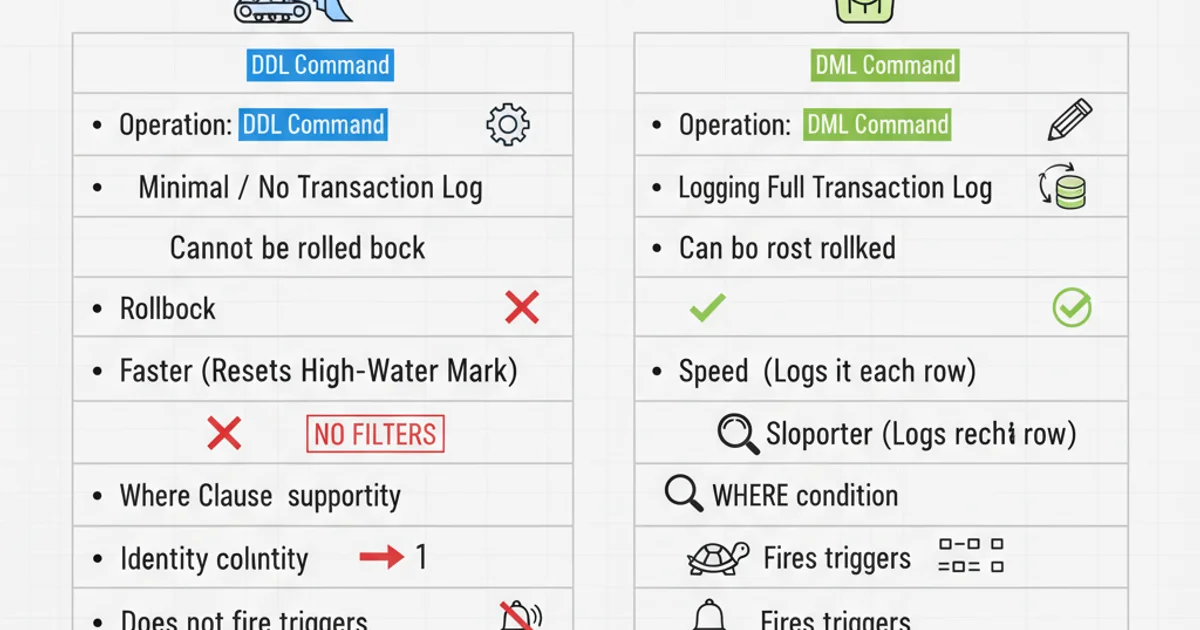Delete all the records
Categories:
Mastering Data Deletion: TRUNCATE vs. DELETE in SQL Server

Learn the critical differences between TRUNCATE TABLE and DELETE FROM statements in SQL Server, understand their use cases, and choose the right method for efficient data removal.
Deleting records from a database table is a fundamental operation in SQL. However, SQL Server offers more than one way to achieve this, primarily through the DELETE and TRUNCATE TABLE statements. While both remove data, they operate very differently under the hood, impacting performance, logging, and transaction management. Understanding these distinctions is crucial for database administrators and developers to ensure data integrity, optimize performance, and manage resources effectively.
Understanding DELETE FROM
The DELETE FROM statement is a DML (Data Manipulation Language) command used to remove one or more rows from a table. It allows for conditional deletion using a WHERE clause, enabling precise control over which records are affected. Each deleted row is logged individually in the transaction log, making the operation fully recoverable. This also means that DELETE operations can trigger DELETE triggers and respect foreign key constraints.
DELETE FROM YourTableName
WHERE YourColumn = 'SomeValue';
Deleting specific rows using a WHERE clause.
DELETE FROM YourTableName;
Deleting all rows from a table without a WHERE clause.
WHERE clause with DELETE unless you explicitly intend to remove all records. For large tables, deleting all records with DELETE can be very slow due to extensive logging.Understanding TRUNCATE TABLE
The TRUNCATE TABLE statement is a DDL (Data Definition Language) command that removes all rows from a table by deallocating the data pages used by the table. It is much faster and uses fewer system resources than DELETE for removing all rows because it logs only the deallocation of data pages, not individual row deletions. TRUNCATE TABLE cannot be used with a WHERE clause, meaning it always removes all records. It also resets identity columns (AUTO_INCREMENT) to their seed value. Unlike DELETE, TRUNCATE TABLE cannot activate DELETE triggers and will fail if foreign key constraints reference the table.
TRUNCATE TABLE YourTableName;
Truncating all rows from a table.
TRUNCATE TABLE is generally non-recoverable in the same way DELETE is. While it can be rolled back if executed within an explicit transaction, it's a much more destructive operation due to minimal logging. Use with extreme caution.Choosing Between TRUNCATE and DELETE
The choice between TRUNCATE TABLE and DELETE FROM depends on your specific requirements. Consider the following factors:
flowchart TD
A[Start] --> B{"Need to delete specific rows?"}
B -->|Yes| C[Use DELETE FROM with WHERE clause]
B -->|No| D{"Need to delete ALL rows?"}
D -->|Yes| E{"Need to reset IDENTITY column?"}
E -->|Yes| F{"No DELETE triggers or FK constraints?"}
F -->|Yes| G[Use TRUNCATE TABLE]
F -->|No| H[Use DELETE FROM without WHERE clause]
E -->|No| H
D -->|No| I[End]
C --> I
G --> I
H --> IDecision flow for choosing between TRUNCATE TABLE and DELETE FROM.
Here's a summary of their key differences:

Key differences between TRUNCATE TABLE and DELETE FROM.
Practical Considerations and Best Practices
When performing data deletion, always prioritize data safety and system performance. Here are some best practices:
1. Backup Your Data
Before executing any large-scale deletion, especially TRUNCATE TABLE, ensure you have a recent backup of your database. This is your primary safeguard against accidental data loss.
2. Test in a Non-Production Environment
Always test your deletion queries in a development or staging environment first to verify the correct rows are being deleted and to assess performance impact.
3. Use Transactions
Wrap your DELETE statements (and TRUNCATE TABLE if supported by your RDBMS) within an explicit transaction. This allows you to ROLLBACK the changes if something goes wrong. Note that TRUNCATE TABLE in SQL Server is minimally logged but can be rolled back if part of an explicit transaction.
4. Monitor Performance
For very large tables, DELETE operations can lock tables for extended periods. Consider deleting data in smaller batches to minimize impact on concurrent users, or schedule deletions during off-peak hours.
5. Reclaim Space (if necessary)
While TRUNCATE TABLE deallocates pages, DELETE does not immediately reclaim space. If space reclamation is critical after a large DELETE, consider rebuilding indexes or shrinking the database/files, but do so cautiously as shrinking can lead to fragmentation.